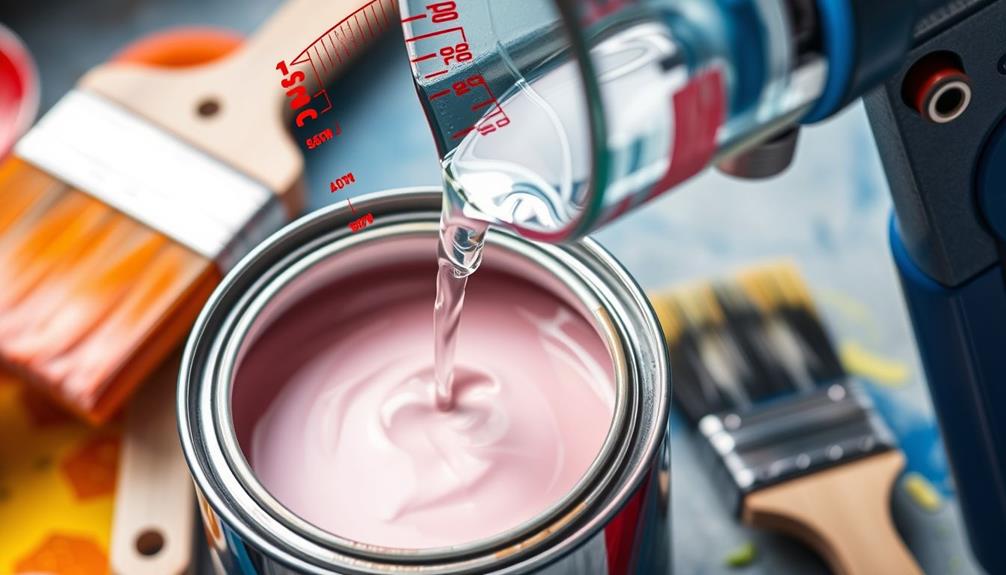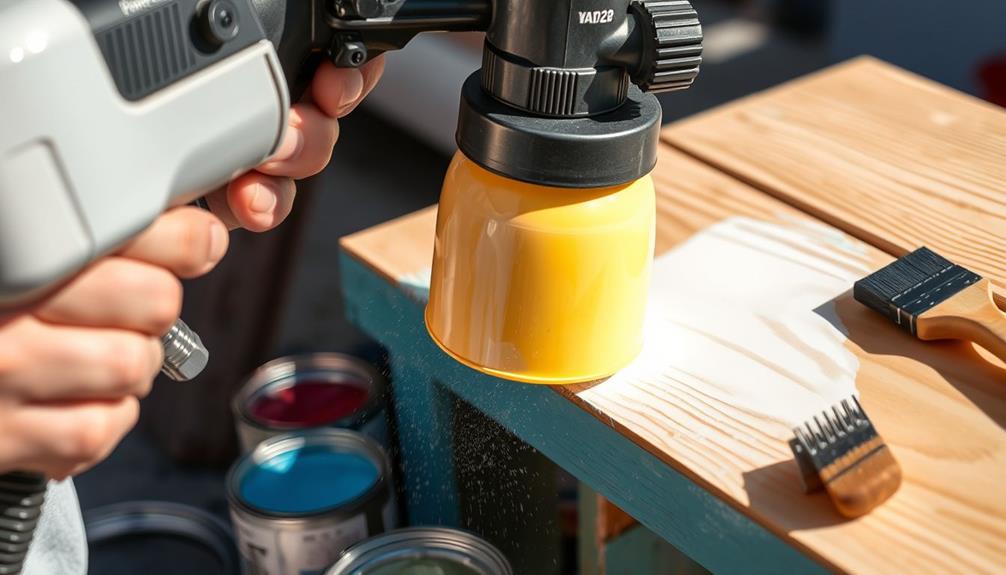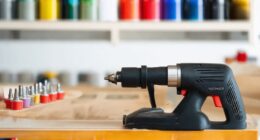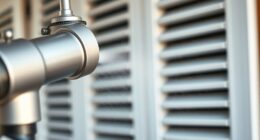To properly thin paint for your airless sprayer, start by pouring latex paint into a clean bucket. Add about half a cup of water per gallon and stir thoroughly without creating bubbles. Test the viscosity using a funnel to check if it flows freely. Aim to thin by 10-15%, but don't exceed one pint of water per gallon to maintain adhesion. Allow the thinned paint to rest for 10-15 minutes before using it. This guarantees a smoother application and minimizes clogs. For tips on achieving the perfect consistency and avoiding common mistakes, you're in the right place.
Key Takeaways
- Assess paint viscosity by observing drip rate, conducting spray tests, or using a funnel flow test to determine if thinning is needed.
- Thin latex paint by adding ½ cup of water per gallon, ensuring not to exceed 1 pint to maintain adhesion.
- Stir paint thoroughly before adding water, and mix gradually to avoid over-thinning and achieve the desired consistency.
- Test thinned paint on a sample surface to ensure proper flow and coverage before full application.
- Allow thinned paint to rest for 10-15 minutes before use to improve flow and reduce clogs in the sprayer.
Understanding Latex Paint
When it comes to modern painting, understanding latex paint is essential. This water-based product, made with synthetic resins, offers several advantages over traditional oil-based paints. Its thinner consistency makes it perfect for use with airless sprayers, allowing you to achieve a smooth finish without the hassle of excessive thinning paint.
Additionally, airless paint sprayers use high pressure to atomize paint, which enhances the overall application process.
One of the key benefits of latex paint is its ease of cleanup. Since it doesn't rely on petroleum-based solvents, you can clean brushes and tools using just soap and water. This makes it a popular choice for DIY enthusiasts and professionals alike.
Latex paint has come a long way since its introduction in the 1940s by Sherwin-Williams as Super Kem-Tone. Today's formulations are specifically designed to work seamlessly with airless spray guns, often eliminating the need for any thinning.
This versatility means you can tackle a variety of projects with confidence, knowing you're using a product that's both effective and user-friendly.
Importance of Thinning Paint

Thinning paint is essential for achieving a smooth and professional finish, especially with airless sprayers. When you thin latex paint, you enhance its flow and leveling properties, which are critical for ideal performance.
Utilizing the right techniques can also help you achieve a fine finish with Graco FFLP Fine Finish Low Pressure Reversible Tip, designed specifically for intricate projects. Over time, paint can thicken due to loss of water content or exposure to high temperatures, leading to clumpy consistency.
Thinned paint helps restore proper consistency, making it easier to apply and ensuring an even coat on surfaces. Using thicker paint can clog your spray equipment, so proper thinning techniques become essential.
When you thin your paint, you not only improve its adherence to surfaces but also minimize the chances of runs and uneven patches. A well-thinned mixture allows your sprayer to create a finer mist, leading to better coverage and a more uniform finish.
Assessing Paint Consistency

To assess paint consistency, start by testing its viscosity with a stick; the drip rate will help you determine if it's too thick.
It's crucial to verify you have the right tools at hand, similar to how a professional uses essential items in their home cleaning kit.
Conduct a spray test on cardboard to identify any thinning indicators, like sputtering or uneven patterns.
These simple methods will guide you in adjusting the paint for peak performance with your airless sprayer.
Viscosity Testing Methods
Evaluating your paint's consistency is essential for achieving a smooth finish with an airless sprayer. You can perform a viscosity test by dipping a stick into the paint and observing the drip rate. A slow, thick stream indicates you might need to thin the paint. To further test the spray performance, apply thinned paint on cardboard; an even spray pattern signifies proper consistency, while sputtering suggests more thinning is necessary.
You can also pour the paint through a funnel to visually check its flow. If it doesn't pour freely, it likely requires additional thinning. Additionally, using a paint strainer can help you check for clogs, ensuring any lumps are removed before spraying.
Here's a quick reference table for your viscosity testing methods:
| Method | What to Look For | Action Required |
|---|---|---|
| Viscosity Test | Slow drip | Thin paint if needed |
| Spray Performance Test | Even spray pattern | Adjust thinning as necessary |
| Funnel Flow Test | Free flow | Thin paint if not flowing well |
Consistent flow and uniformity during these tests indicate that your paint is ready for application.
Identifying Thinning Indicators
Recognizing the signs that your paint needs thinning is essential for achieving ideal results with an airless sprayer. Start by conducting a viscosity test. Dip a stick into the paint and observe the drip rate. If you notice a slow, thick stream, it's time to thin the paint.
Additionally, take into account the environment in which you're painting, as factors like temperature and humidity can affect paint consistency and performance. For example, unique cultural experiences during travel can inspire your choice of colors and textures in your home projects.
Next, spray a sample on cardboard to check for spray consistency. If the paint sputters or leaves globs, it clearly requires thinning for best performance. A uniform flow during your test indicates that the paint may not need further thinning, ensuring a smoother application.
Remember to test the paint's spray consistency before application to avoid clogs or uneven coverage. Regularly assess the paint's consistency, especially if it's been sitting for a while. Older paint tends to thicken, so you may need to take into account thinning latex to achieve the right viscosity.
Thinning Process Steps

Before you start thinning your paint, it's important to have a clean 5-gallon bucket ready. Proper preparation is key for achieving the best results, just like confirming your garage door openers are properly installed for maximum security.
Follow these steps to confirm your paint is properly thinned for your spray gun:
- Pour the Paint: Begin by pouring the latex paint into your clean bucket. For every gallon of paint, add approximately ½ cup (118 milliliters) of clean, room temperature water.
- Stir Thoroughly: Use an up-and-down motion to mix the paint and water. Be careful to avoid excessive bubbles while confirming even mixing.
- Test Viscosity: After mixing, test the paint's viscosity by pouring it through a funnel. If it doesn't flow freely, gradually add an additional ⅓ cup (30 milliliters) of water per gallon and mix again.
- Let it Sit: Allow the thinned paint to sit for 10-15 minutes before use. This will confirm proper incorporation of water and help you achieve the desired consistency.
Proper Thinning Techniques

Achieving the perfect paint consistency is fundamental for a smooth and even finish when using an airless sprayer. To thin latex paint effectively, start by thoroughly stirring it to guarantee an even mixture.
Cats, much like paint, require proper care and attention to avoid issues—cat health and nutrition is essential for their well-being. Use a separate clean bucket for mixing, and gradually add water in small increments. Scrape the sides and bottom of the bucket as you mix, employing an up-and-down stirring motion to minimize bubbles that could affect your spray finish.
Once you've combined the paint and water, let the thinned paint sit for 10-15 minutes. This waiting period allows for proper incorporation of the water, which is critical for achieving the right consistency.
Before you immerse yourself in your final application, always test the thinned paint on a sample surface. This step confirms its flow and performance, verifying you're ready to proceed confidently.
If you find that the mixture isn't flowing well, you might need to adjust it further. Using a paint strainer can help filter out any lumps that may have formed during mixing, guaranteeing the best way to thin your paint.
Following these proper thinning techniques will set you up for success with your airless sprayer.
Tips for Successful Thinning

When thinning paint, it's essential to follow specific guidelines to get the right consistency without overdoing it.
Maintaining a healthy lifestyle, as discussed in various healthy lifestyle blogs, can also enhance your overall energy and focus during projects like these.
Always thin only what you'll use right away to maintain quality, and choose a high-quality latex paint designed for airless sprayers for the best results.
Thinning Quantity Guidelines
Success in thinning paint for an airless sprayer hinges on following precise guidelines. When working with latex paint, it's crucial to adhere to specific thinning quantity guidelines to achieve the best results.
To maintain a healthy indoor environment while working on your painting project, consider using an air purifier to reduce dust and allergens.
Here's what you need to know:
- Thinning Ratio: Generally, thin latex paint by 10-15%. This means adding about 1/8 to 1/4 cups of water to each gallon.
- Maximum Limit: Never exceed 1 pint of water per gallon. Too much thinning can compromise adhesion and finish quality.
- Incremental Testing: After each addition of water to thin, test the consistency. This helps guarantee ideal flow and performance before you start spraying.
- Immediate Use: Only thin paint you plan to use right away. This prevents spoilage and promotes a consistent application.
Immediate Use Importance
Thinning paint for immediate use is essential to preventing spoilage and guaranteeing a consistent application. When you thin paint, it's important to prepare only what you need for your project. Always thin paint in small batches—typically no more than a gallon at a time—to avoid the risk of over-thinning the entire can. This approach not only helps maintain the quality but also minimizes waste.
Additionally, using quality latex paint specifically designed for airless spraying will yield best results when thinned appropriately, similar to how projector maintenance tips can enhance the longevity of your devices. For professional results, consider using the AEROPRO AP8628 sprayer, as it assures effective atomization and coverage with your thinned paint.
Before you start spraying, always conduct a viscosity test after thinning to confirm the paint's flow is suitable for your airless sprayer. This step is significant, as it determines whether your paint will apply smoothly or if further adjustments are needed.
Quality Paint Selection
Choosing the right paint is essential for achieving perfect results with your airless sprayer. Quality latex paint specifically designed for airless spraying minimizes the need for thinning and enhances performance. Additionally, understanding innovative architectural solutions can inspire creative applications for your painting projects.
Here are some tips to help you select the best paint:
- Opt for High-Quality Paint: Always choose premium latex paint to avoid excessive thinning and guarantee a smooth finish.
- Check Sprayer Compatibility: Confirm the paint is suitable for your sprayer model. Some sprayers can handle unthinned paint, while others might require a specific thinning ratio for best flow.
- Test Before Full Application: Always test a small quantity of paint on a sample surface. This helps you determine the perfect thinning ratio and guarantees compatibility with your sprayer.
- Consider Professional Equipment: Using a reliable sprayer like the AEROPRO AP8628 can make a significant difference. It's designed to handle various paint viscosities efficiently, resulting in a professional finish.
Common Thinning Mistakes

Many DIYers make common thinning mistakes that can compromise their paint job. One major error is over-thinning paint, which often leads to a poor finish and increased runs. When you're adding water to thin your paint, be careful not to go overboard, as excessive thinning can hinder the paint's ability to adhere properly to surfaces.
Another mistake is using solvents like paint thinner instead of water for latex paints. This can ruin the paint's integrity and performance. Always stick to the recommended thinning method for the specific type of paint you're using.
Failing to conduct a viscosity test before you start thinning can also lead to issues. If you don't check the paint's thickness first, you might end up thinning it too much, making it tough to achieve even coverage.
Additionally, neglecting to stir the paint thoroughly before adding water can result in an uneven consistency, causing performance problems during spraying.
Finally, if you're thinning paint meant for long-term storage, remember that this can lead to spoilage—only thin paint you plan to use immediately.
Avoid these mistakes, and you'll set yourself up for a successful painting project.
Final Considerations for Spraying

Before you start spraying, it's crucial to guarantee your paint is properly prepared for the airless sprayer. This means paying close attention to the viscosity and following the manufacturer's recommendations. Here are some final considerations to keep in mind:
- Thinning: Ideally, thin latex paint by no more than 10-15% with water for best flow. Remember, excessive thinning can lead to longer drying times and might require extra coats.
- Monitor the Spray Pattern: As you spray, keep an eye on the pattern. A smooth, even spray is a good sign that your paint is thinned correctly. If you notice sputtering or inconsistent coverage, it may need further adjustment.
- Let It Sit: After thinning, allow your paint to rest for 10-15 minutes. This helps promote proper incorporation and can reduce clogs in your sprayer.
- Consult the Manual: Always refer to your airless sprayer's manual for specific guidelines regarding paint consistency. Different models have varying requirements that could impact your results.
Frequently Asked Questions
How Do You Thin Paint for an Airless Spray Gun?
To thin paint for an airless spray gun, mix in 10-15% water, using clean, room temperature water. Test the viscosity by pouring it through a funnel until it flows freely for best performance.
How Much to Thin Paint for an Airless Sprayer?
To thin paint for your airless sprayer, aim for 10-15% dilution, which means adding 1/8 to 1/4 cup of water per gallon. Don't exceed 1 pint to maintain paint performance. Always check manufacturer guidelines.
What Is the Ratio of Paint to Thinner for a Spray Gun?
When thinning paint for a spray gun, start with a 10% water-to-paint ratio. If needed, adjust up to 20%, but remember to test the viscosity to guarantee it flows smoothly without clogging.
How Much Water to Thin a Gallon of Paint?
Did you know that nearly 70% of DIY painters struggle with paint consistency? To thin a gallon of paint, start by adding ½ cup of water, mix well, and adjust for the desired flow.
Conclusion
In summary, properly thinning paint for your airless sprayer is vital for achieving a smooth finish. Did you know that over 50% of paint application issues stem from incorrect consistency? By following the steps and techniques outlined, you can avoid common mistakes and guarantee a successful project. Remember, the right thickness not only improves the sprayer's performance but also enhances the overall appearance of your work. So, take the time to thin your paint correctly and enjoy the results!










